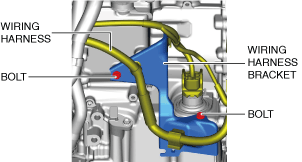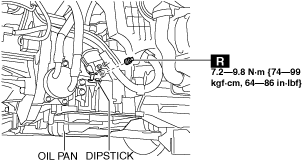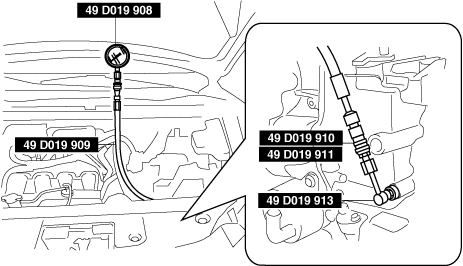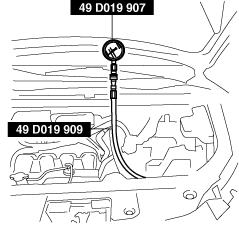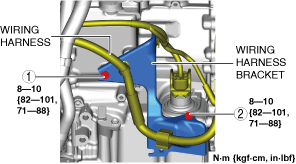MECHANICAL SYSTEM TEST [EV6A-EL, EV6AX-EL]
MECHANICAL SYSTEM TEST [EV6A-EL, EV6AX-EL]
SM2566196
id0517o3118300
Special Service Tool (SST)
|
49 D019 907
Oil pressure gauge
(Part of 49 D019 9A2)
|
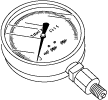 |
49 D019 908
Gauge
(Part of 49 D019 9A2)
|
 |
49 D019 909
Hose
(Part of 49 D019 9A2)
|
 |
|
49 D019 910
Adapter
(Part of 49 D019 9A2)
|
 |
49 D019 911
Adapter
(Part of 49 D019 9A2)
|
 |
49 D019 913
Adapter
(Part of 49 D019 9A2)
|
 |
Replacement Part
|
Square head plug
Quantity: 1
Location of use: Automatic transaxle
|
Mechanical System Test Preparation
1.Apply the parking brake firmly, and set the wheel blocks for both the front and rear wheels.
2.Inspect the engine coolant level. (See ENGINE COOLANT LEVEL INSPECTION [SKYACTIV-G (WITH CYLINDER DEACTIVATION (US))].)
3.Inspect the engine oil level. (See ENGINE OIL LEVEL INSPECTION [SKYACTIV-G (WITH CYLINDER DEACTIVATION (US))].)
4.Inspect the ATF level. (See AUTOMATIC TRANSAXLE FLUID (ATF) INSPECTION [EV6A-EL, EV6AX-EL].)
5.Inspect the ignition timing. (See ENGINE TUNE-UP [SKYACTIV-G (WITH CYLINDER DEACTIVATION (US))].)
6.Inspect the idle speed. (See ENGINE TUNE-UP [SKYACTIV-G (WITH CYLINDER DEACTIVATION (US))].)
7.Verify that no DTCs are stored.
Line Pressure Test
1.Perform the mechanical system test preparation. (See Mechanical System Test Preparation.)
2.Disconnect the negative battery terminal. (See NEGATIVE BATTERY TERMINAL DISCONNECTION/CONNECTION [(US)].)
3.Remove the following parts as a single unit. (See INTAKE-AIR SYSTEM REMOVAL/INSTALLATION [SKYACTIV-G (WITH CYLINDER DEACTIVATION (US))].)
-
• Air cleaner cover• Air cleaner element• Fresh-air duct• Air cleaner case• Air hose• Resonance chamber
4.Remove the bolts and set the wiring harness and wiring harness bracket in a place which does not interfere with servicing.
am3zzw00021692
|
5.Remove the pressure detection square head plug.
-
Warning
-
• Do not remove the square head plug when the ATF temperature is high. Otherwise, ATF could overflow and cause severe burns or serious injury. Remove the square head plug when the transaxle and ATF temperatures are low.
-
Note
-
• Use a suitable oil pressure gauge that corresponds to the line pressure because the maximum scale value differs depending on the oil pressure gauge.
am6xuw00009680
|
6.Install SSTs (49 D019 908, 49 D019 909, 49 D019 910, 49 D019 911, 49 D019 913) to the line pressure detection port as shown in the figure.
ac9uuw00007089
|
7.Install the following parts as a single unit. (See INTAKE-AIR SYSTEM REMOVAL/INSTALLATION [SKYACTIV-G (WITH CYLINDER DEACTIVATION (US))].)
-
• Air cleaner cover• Air cleaner element• Fresh-air duct• Air cleaner case• Air hose• Resonance chamber
8.Connect the negative battery terminal. (See NEGATIVE BATTERY TERMINAL DISCONNECTION/CONNECTION [(US)].)
9.Start the engine.
10.Warm up the engine until the ATF temperature is 60—70 °C {140—158 °F}.
11.Shift the selector lever to the D position.
12.Measure the line pressure while idling in D position.
13.Measure the line pressures while idling in the M (1st gear) and R positions using the same procedure.
14.Stop the engine.
15.Change the low-pressure gauge (49 D019 908) to the high-pressure gauge (49 D019 907).
ac4ccw00002085
|
16.Start the engine.
17.Measure the line pressure while stalling in D position.
- (1)Strongly depress the brake pedal with the left foot.
- (2)Shift the selector lever to the D position.
-
-
Caution
-
• To prevent damage to the transaxle, measure the line pressure while stalling (Step (3) —(4)) within 5 s.
-
- (3)Slowly depress the accelerator pedal fully with the right foot all the way down.
- (4)Read the line pressure quickly while stalling, and remove the right foot from the accelerator pedal.
- (5)Shift the selector lever to the N position and idle for 1 min or more.
18.Measure the line pressure while stalling for positions other than D in the same procedure.
-
• If there is any malfunction, one of the following causes may have occurred:
|
Condition |
Possible cause |
|
|---|---|---|
|
Lower than specification
|
Lower in R, D, and M (1GR) position
|
• Oil pump wear
• ATF leakage from oil pump, control valve body, and transaxle case
• Pressure regulator valve sticking
• Pressure control solenoid operation malfunction
• Solenoid reducing valve sticking
|
|
Lower in D and M (1GR) position
|
• ATF leakage from low clutch hydraulic circuit
|
|
|
Lower in R and M (1GR) position
|
• ATF leakage from low and reverse brake hydraulic circuit
|
|
|
Lower in R position
|
• ATF leakage from R-3-5 brake hydraulic circuit
|
|
|
Higher than specification
|
Higher in R, D, and M (1GR) position
|
• Pressure regulator valve sticking
• Pressure control solenoid operation malfunction
|
Line pressure
|
Measurement conditions |
Specification (kPa {kgf/cm2, psi}) |
|
|---|---|---|
|
Idling
|
R position
|
500—700 {5.10—7.13, 72.6—101.0}
|
|
D and M (1GR) position
|
330—470 {3.37—4.79, 47.9—68.1}
|
|
|
Stalling
|
R position
|
1,790—2,100 {18.26—21.41, 259.7—304.5}
|
|
D and M (1GR) position
|
970—1,170 {9.90—11.93, 141.0—169.6}
|
|
19.Stop the engine.
20.Disconnect the negative battery terminal. (See NEGATIVE BATTERY TERMINAL DISCONNECTION/CONNECTION [(US)].)
21.Remove the following parts as a single unit. (See INTAKE-AIR SYSTEM REMOVAL/INSTALLATION [SKYACTIV-G (WITH CYLINDER DEACTIVATION (US))].)
-
• Air cleaner cover• Air cleaner element• Fresh-air duct• Air cleaner case• Air hose• Resonance chamber
22.Remove the SSTs.
-
Warning
-
• If the SST is removed when the ATF temperature is high, ATF could overflow and cause severe burns or serious injury. Remove the SST when the transaxle and ATF temperatures are low.
23.Install a new square head plug.
-
Note
-
• Do not reuse the square head plug because a sealant coating has been applied.
am6xuw00009680
|
24.Tighten the wiring harness bracket installation bolts in the order shown in the figure.
am3zzw00031569
|
25.Install the following parts as a single unit. (See INTAKE-AIR SYSTEM REMOVAL/INSTALLATION [SKYACTIV-G (WITH CYLINDER DEACTIVATION (US))].)
-
• Air cleaner cover• Air cleaner element• Fresh-air duct• Air cleaner case• Air hose• Resonance chamber
26.Connect the negative battery terminal. (See NEGATIVE BATTERY TERMINAL DISCONNECTION/CONNECTION [(US)].)
Stall Test
1.Perform the mechanical system test preparation. (See Mechanical System Test Preparation.)
2.Apply the parking brake firmly, and set the wheel blocks for both the front and rear wheels.
3.Start the engine.
4.Measure the stall speed in the D position.
- (1)Strongly depress the brake pedal with the left foot.
- (2)Shift the selector lever to the D position.
-
-
Caution
-
• To prevent damage to the transaxle, measure the stall speed (Step (3) —(4)) within 5 s.
-
- (3)Slowly depress the accelerator pedal fully with the right foot all the way down.
- (4)Read the engine speed quickly when the speed is stabilized, and remove the right foot from the accelerator pedal.
- (5)Shift the selector lever to the N position and idle for 1 min or more.
5.Measure the stall speed in the M (1st gear) and R positions using the same procedure.
-
• If there is any malfunction, one of the following causes may have occurred:
|
Condition |
Possible cause |
||
|---|---|---|---|
|
Higher than specification
|
Higher in R, D, and M (1GR) position
|
Line pressure is low
|
• Oil pump wear
• ATF leakage from oil pump, control valve body, and transaxle case
• Pressure regulator valve sticking
• TR control valve sticking
• Pressure control solenoid operation malfunction
|
|
• Low and reverse brake slippage, and damage of one-way clutch
|
|||
|
Higher in D and M (1GR) position
|
• Low clutch slippage
• One-way clutch damage
|
||
|
Higher in R position
|
Perform road test to determine whether problem is in R-3-5 brake or low and reverse brake
• Engine brake operates in M (1GR) position
• Engine braking does not operate in M (1GR) position
|
||
|
Lower than specification
|
Lower in R, D, and M (1GR) position
|
• Engine malfunction
• One-way clutch slippage in torque converter
|
|
Stall speed
|
Measurement conditions |
Standard value (rpm) |
|---|---|
|
R position
|
1,700—2,200
|
|
D position
|
2,200—2,900
|
|
M position
|
Time Lag Test
1.Perform the mechanical system test preparation. (See Mechanical System Test Preparation.)
2.Apply the parking brake firmly, and set the wheel blocks for both the front and rear wheels.
3.Start the engine.
4.Measure the time lag from the N position to the D position.
- (1)Shift the selector lever from the N position to the D position with the brake pedal depressed.
- (2)Measure the time until the shift shock is felt firmly after shifting.
5.Measure the time lag from the N position to the R position using the same procedure.
-
• If there is any malfunction, one of the following causes may have occurred:
|
Condition |
Possible cause |
|
|---|---|---|
|
N to D selected
|
Longer than specification
|
• Line pressure is low
• Low clutch slippage
• ATF leakage from low clutch hydraulic circuit
• ATF leakage from low and reverse brake hydraulic circuit
• Shift solenoid No.1 operation malfunction
• Shift solenoid No.4 operation malfunction
|
|
Shorter than specification
|
• Line pressure is high
• N-D accumulator operation malfunction
• Shift solenoid No.1 operation malfunction
• Shift solenoid No.4 operation malfunction
|
|
|
N to R selected
|
Longer than specification
|
• Line pressure is low
• Low and Reverse brake slippage
• R-3-5 brake slippage
• ATF leakage from R-3-5 brake hydraulic circuit
• ATF leakage from low and reverse brake hydraulic circuit
• Shift solenoid No.3 operation malfunction
• Shift solenoid No.4 operation malfunction
|
|
Shorter than specification
|
• Line pressure is high
• N-R accumulator operation malfunction
• Shift solenoid No.3 operation malfunction
• Shift solenoid No.4 operation malfunction
|
|
Time lag
|
Measurement conditions |
Specification (s) |
|---|---|
|
N to D selected
|
0.4—0.7
|
|
N to R selected
|
